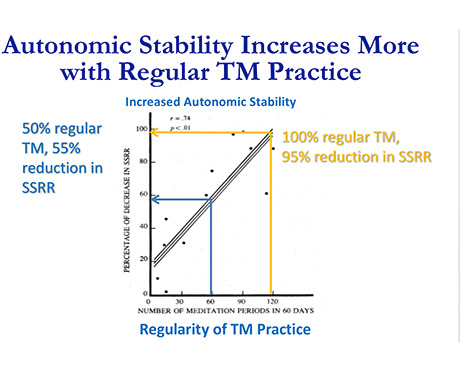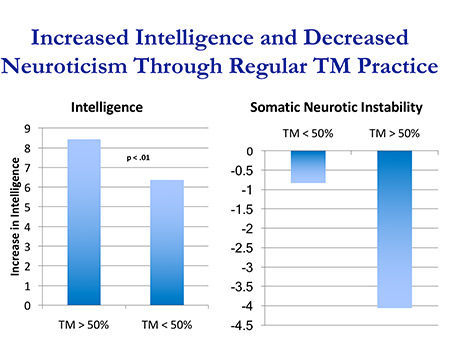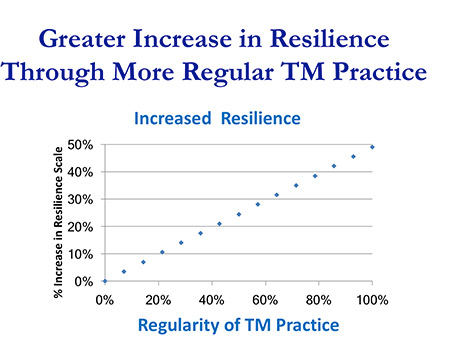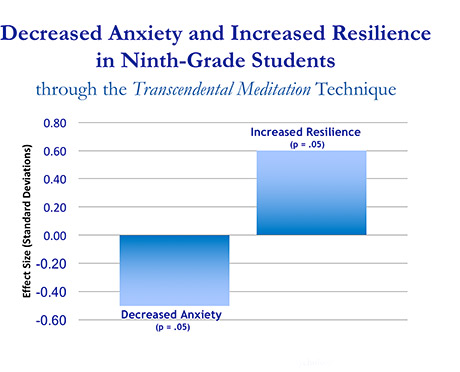Do you have a science question for Dr. David Orme-Johnson? Please send your query to editors@enjoytmnews.org. As one of the principal researchers on the Transcendental Meditation® technique worldwide, with over 100 publications, Dr. Orme-Johnson has presented TM research in more than 56 countries to scientific conferences, government officials, and the United Nations.
Question: My TM instructor says that meditating twice a day will bring me the greatest benefits, but with work and family, sometimes it’s hard to get in both my TM sessions. How important is it to meditate twice a day, every day?
Dr. Orme-Johnson: This regularity is very important. Multiple studies have shown that benefits from the Transcendental Meditation® (TM®) technique are directly proportional to regularity of practice. Anything less produces fewer benefits.
Research shows that people who practice the TM technique twice a day, every day, experience a greater decrease in neuroticism, heart attacks, strokes, and death. In addition, they gain much more in autonomic stability (indicates less stress), resilience, intelligence, and sociability.
A Quick Summary of Research on the Striking Benefits of Regular TM Practice

1. Far less stress: One study showed that in subjects who practiced the TM technique twice a day over a two-month study (120 times), their spontaneous skin resistance responses (SSRRs), a measure of stress, decreased 95 percent. Practicing TM only once a day (60 times) resulted in only a 55 percent reduction in SSRRs.
2. Increased intelligence, decreased neuroticism: A 16-month study of 76 college and university students and adults in the Netherlands found that meditating more than once a day produced a 32 percent greater increase in intelligence, and an almost four times greater reduction in somatic neurotic instability than meditating less than once a day. 22 The study also showed that fluid intelligence and extraversion increased, and somatic neurotic instability and neuroticism decreased, in proportion to how regularly a person practiced TM.
3. Reduced heart attacks, strokes, and death: In an NIH-funded, randomized, controlled trial of elderly heart patients, those practicing the TM technique (n=99) an average of 61 percent of the time (8.5 times per week) experienced a 48 percent reduction in the risk of heart attacks, strokes, and death compared to health education controls (n=102). The regular TM subgroup—on average 83 percent regular (11.6 meditations per week)—had 66 percent fewer clinical events than controls. The more frequent TM practice reduced heart attacks, strokes, and death by another 18 percent.10
4. Greater resilience and coping ability: A study of 103 ninth-grade students practicing the TM technique found a significant correlation between regularity of TM practice and gains in resilience, indicating greater emotional capability to cope with stress.27 Students who meditated twice a day, every day, showed a 50 percent increase in the resilience scale. Those who practiced TM only once a day improved half as much.
Studies have shown that benefits from the Transcendental Meditation technique are directly proportional to regularity of practice.
Why Does Meditating Twice a Day Make Such a Difference?
There are two main reasons for regular meditation: release of stress and increased brain integration.
Release of Stress. The physiological effects of the TM technique are exactly the opposite of stress. Stress speeds up the heart, makes us breathe faster and perspire, and increases blood levels of cortisol, a major stress hormone. TM practice has the opposite effects,1-3 and regular TM practice dissolves stress twice a day. As a result,
- our stress levels decrease outside of meditation, during our daily activity,1, 4
- we become more resilient,5, 6
- we are less anxious,7, 8
- and our health improves across all disease categories.9-12
Brain Integration. Research shows that during TM practice, as the mind settles, the brain becomes profoundly integrated. This is seen in the laboratory as increased EEG or brain wave coherence. When we come out of meditation and engage in our daily activity, at first only some of the brain integration gained during meditation lasts.
But over time, with many additional cycles of twice-daily TM practice alternated with activity, more and more of the brain coherence experienced during meditation lasts into activity.13-15
Practicing TM twice a day is optimal for dissolving stress and habituating the nervous system to maintain the high level of brain integration that we experience during meditation, even while we’re engaged in activity. This increased brain coherence gained through regular TM practice is correlated with increased
- creativity,16
- concept learning,17
- moral reasoning,18
- self-esteem,14
- and decreased anxiety.14
If we don’t meditate regularly, we won’t be able to get the full benefits of this process and the TM technique.
Practicing TM twice a day is optimal for dissolving stress and habituating the nervous system to maintain the high level of brain integration experienced during meditation, even while we’re engaged in activity.
Does Practicing TM Regularly Reduce Stress More Than Sporadic Practice?
To answer this question, I need to tell you about the very first study that discovered the importance of regularity of TM practice.19,20 I conducted this study at La Tuna Federal Penitentiary as a new professor in psychology at the University of Texas at El Paso (UTEP). I had just learned TM a few months earlier, and doing this research taught me how important it is to meditate twice a day.

La Tuna Federal Penitentiary, Anthony, Texas
It was 1970. My wife Rhoda and I and several other new El Paso meditators were returning from a weekend TM Retreat in Las Cruces, New Mexico, laughing and joking, full of bliss. As we passed the La Tuna Prison, looming out of the desert like a castle, we fell silent.
Then there was a collective Aha! moment. “Those guys could be meditating all the time! Prison life could be a long TM Retreat.”
At the time, I was in the middle of my research on TM and autonomic stability, an indicator of reduced stress. We were measuring spontaneous skin resistance responses (SSRRs), mini stress responses that we make even while sitting and resting with our eyes closed. Internal mental turbulence and physiological instability cause our hands to perspire slightly. These SSRRs are telltale signs of how much stress a person is carrying around.5
I had found that our group of El Paso meditators had fewer SSSRs than control subjects of similar age and gender, which meant that they were less stressed. Now we needed to do a longitudinal study. This would follow changes in people from before they learned TM until after they had been practicing it for some time.
I thought the prison would be an ideal place to carry out a longitudinal study because we would know where to find the participants for post-testing. It turned out I was wrong about that, but as you’ll see, it led to our discovery of the importance of regular meditation.
Opening New Doors in Rehabilitation
First, we had to convince La Tuna Penitentiary to do the study. Rhoda, the most persuasive of our group, arranged a meeting to discuss a research plan with the warden, the assistant warden, and a psychologist, Dr. John Kiehlbauch, who was conducting a program for the Narcotics Rehabilitation Act at La Tuna.
The warden was skeptical. He thought we were very naïve to believe that prison inmates would meditate or that it would do them any good. But the assistant warden was enthusiastic, and Dr. Kiehlbauch wanted to add psychological measures to the study, so the warden approved it.
We were inspired that we would be doing something historic, which we hoped would open the door to more effective rehabilitation in the United States and the world.
The next time a TM teacher came through El Paso, we organized an introductory talk at the prison. Gene Spiegel gave a lively presentation to about 40 inmates. When he asked if I wanted to add anything, I said “Nope,” only slightly terrified. The men all laughed.
When Gene asked if they had any questions, someone shouted, “Teach it to the guards!” More laughter. None of the guards started, but the inmates who wanted to learn TM signed up. Those who weren’t interested agreed to be part of the control group.
Word was sent to Maharishi Mahesh Yogi that the first study on prisoners learning TM was about to begin. He sent word back that “we would be opening up doors.” We were inspired that we would be doing something historic, which we hoped would open the door to more effective rehabilitation in the United States and the world.
Discovering the Connection between Regularity and TM Benefits
On the day of the pretest, after going through a series of inner gates, we set up our equipment in a room overlooking a drab courtyard. Rick Moore, one of my UTEP students, and I did the physiological measurements. A few days later, John Baudoux, a fellow Texan, taught the inmates TM in the usual four-day course of instruction.
Now we would wait two months for post-testing. Rhoda and I went off to Humboldt, California, for the first part of a TM teacher training course with Maharishi. This was a life-changing experience for both of us, which she has written about.21
When we returned, I was dismayed to find that a policy of moving inmates between prisons to keep gangs from forming had caused us to lose many subjects!
Furthermore, no place had been set aside for the men to meditate, so very few meditated regularly. They only had bunk beds in communal rooms without privacy. But one man found a way to do his TM regularly despite these obstacles—he meditated every day in a broom closet!
I was about to throw in the towel and give up on the study, when I had an idea.

Autonomic stability, an indicator of reduced stress, increased in proportion to how regularly a person practiced the TM technique. The diagonal line shows a greater percent decrease in spontaneous skin resistance responses (SSRRs) as a function of increasing regularity of practice.
Why not see if there is a correlation between how many times the men had practiced TM over the two-month period and how much their SSRRs decreased? The number of times they’d meditated spanned the gamut from 120 (twice a day) to zero (stopped meditating), a good situation for a correlation analysis.
The results were surprisingly conclusive. We found that there was a strong linear correlation of .74, between regularity of TM practice and reduction in SSRRs.
For example, for people who practiced TM twice a day over the two-month study (120 times), their SSRRs, a measure of stress, decreased 95 percent. Practicing TM only once a day (60 times) resulted in only a 55 percent reduction in SSRRs—a highly significant difference.
This result indicates that the more regularly the inmates meditated, the more autonomic stability they gained. Therefore this study illustrates the general principle that the benefits of TM are roughly proportional to how regularly one meditates.
This study illustrates the general principle that the benefits of TM are roughly proportional to how regularly one meditates.
The “Orme-Johnson Principle of Regular TM Practice”
The La Tuna study also found that regular meditators, defined here as meditating more than 50 percent of the time, decreased more on obsessive compulsiveness than did irregular meditators. They also increased more in social ease and outgoingness than the controls, whereas the irregular meditators did not.
There was also an interesting correlation between reduction of SSRRs and reduction of obsessive compulsiveness (r = .68). This indicates that the more regularly a person meditated the more physiological stability and behavioral flexibility (reduced compulsiveness) he gained, accompanied by increased social outgoingness.
The more regularly a person meditated the more physiological stability and behavioral flexibility (reduced compulsiveness) he gained, accompanied by increased social outgoingness.
Two years later Rhoda and I were now TM teachers ourselves, and I was the Director of the International Center for Scientific Research on the TM program. In a meeting in Switzerland with Maharishi and other researchers, the custom of naming scientific principles after the scientists who discovered them (such as Einstein’s Theory of Relativity) came up for discussion.
Maharishi said we should name scientific principles after scientists working with Maharishi European Research University (MERU). I told him about my La Tuna results, and he said we should call it the “Orme-Johnson Principle of Regular TM Practice.”
Does More Regular TM Practice Affect Our Intelligence and Emotions?
In a word, yes. Not long after I did my La Tuna study, a 1975 study in the Netherlands on young adults also found a correlation between more regular meditation and greater benefits—this time in increased intelligence and sociability, and reduced neuroticism.

The increase in intelligence in the adults who practiced TM more than once a day was 32% more than the increase in those meditating less than once a day. More regular TM practice also produced an almost four times greater reduction in somatic neurotic instability than irregular meditation.
Dr. Andre Tjoa conducted a 16-month study of 76 college and university students and adults. Dr. Tjoa’s study found that meditating more than once a day produced a 32 percent greater increase in intelligence, and an almost four times greater reduction in somatic neurotic instability than meditating less than once a day.22
Like the La Tuna study, Dr. Tjoa’s study also showed that fluid intelligence and extraversion increase, and somatic neurotic instability and neuroticism decrease, in proportion to how regularly a person practiced TM.
Meditating more than once a day produced a 32 percent greater increase in intelligence, and an almost four times greater reduction in somatic neurotic instability than meditating less than once a day.
What Exactly Does Increased Fluid Intelligence Indicate?
Fluid intelligence is the ability to find solutions to problems in novel situations for which prior experience and learning do not prepare you. Several studies have indicated that TM practice increases fluid intelligence by approximately two IQ points per year.23-26
This is a unique and historic discovery, because fluid intelligence is generally believed not to develop further after early adulthood.
Dr. Tjoa’s study in the Netherlands further demonstrated that regular TM practice increases fluid intelligence significantly faster than irregular practice. Who wouldn’t want that!
Is It Significant That Regular TM Practice Reduces Somatic Neurotic Instability Four Times More Than Irregular Practice?
Very significant. Individuals who score high on somatic neurotic instability are likely to be unusually moody and to experience such feelings as anxiety, worry, fear, anger, frustration, envy, jealousy, guilt, depressed mood, and loneliness. People with somatic neurotic instability respond poorly to stressors and are more likely to interpret ordinary situations as threatening and minor frustrations as hopelessly difficult.
The exceptionally strong effect of regular TM practice on somatic neurotic instability suggests that one of the greatest benefits of TM is to create a momentum of stability deep in the personality, which is not achieved nearly as quickly by irregular meditation.
This psychological outcome coincides with the La Tuna finding that regular TM practice rapidly stabilizes the autonomic nervous system, because the autonomic nervous system is part of the physiological basis of emotions.5
One of the greatest benefits of TM is to create a momentum of stability deep in the personality, which is not achieved nearly as quickly by irregular meditation.
Moreover, there is new clinical evidence that regular TM practice more rapidly and profoundly reduces symptoms of Post-Traumatic Stress (PTS) in veterans than does irregular practice. 6 (This new study on PTS will be described in more detail in an upcoming issue of Enjoy TM News.)
Thus we see from several points of view—physiology (autonomic stability), emotions (somatic neurotic stability), cognitive (intelligence), and clinical (PTS)—that regular TM practice rapidly habituates the system to strengthen the very core of our being.
If Regular TM Practice Strengthens the “Core of Our Being,” Can It Do Anything for Serious Health Problems, Such as Heart Attacks and Strokes?

In an NIH-funded, randomized, controlled trial of older, high-risk heart patients, those practicing TM (n=99) an average of 61% of the time (8.5 times per week) experienced a 48% reduction in the risk of heart attacks, strokes, and death compared to health education controls (n=102). The regular TM subgroup (on average 83% regular, 11.6 meditations per week) had 66% fewer clinical events than controls. The more frequent TM practice reduced heart attacks, strokes, and death by another 18%.
Yes! An NIH-funded, randomized, controlled trial of elderly heart patients over a 5.4-year period found that the TM group, who practiced an average of 61 percent of the time (a little more than once a day), had a 48 percent reduction in risk of heart attacks, strokes, and death compared to a health education control group who were not instructed in the TM technique.10
It gets even better. A subgroup who were “high adherence” and practiced TM 83 percent of the time (often twice a day) had a 66 percent reduction in their risk of heart attacks, strokes, and death compared to controls.10
The greater the regularity of TM practice, the greater the reduction in the risk of heart attacks, strokes, and death.

Regular TM practice, measured on a scale of 0 to 2 times per day (horizontal axis) was associated with risk reduction of heart attacks, strokes, and death (horizontal vertical axis). Regular TM practice (twice a day) was associated with a 74 percent reduction in risk.
Moreover, as with the studies on autonomic stability, intelligence, and somatic neurotic instability, the greater the regularity of TM practice, the greater the reduction in the risk of heart attacks, strokes, and death. Regular TM practice, twice a day, was associated with a 74 percent reduction in risk.
Heart attacks and strokes are the most widespread and costly health problem facing the U.S., responsible for 1.5 million deaths at a cost of $316.6 billion per year.30 If all U.S. heart patients practiced TM regularly, a 74 percent reduction projects into 1.11 million fewer deaths and $234.3 billion saved.
OK, So Regular TM Is Good for Young Adults and Elders, but What about Kids?
Good question. We all want our children to grow up to be strong, healthy, intelligent, and happy. One of the best things we can do to help them is to have them learn the TM technique early in life and explain the great value of regular TM practice as they grow up.

For 103 ninth-graders who learned the TM technique, their gain in resilience was directly proportional to the regularity of TM practice.
A study of 103 ninth-grade students found a significant correlation between regularity of TM practice and gains in resilience, indicating greater emotional capability to cope with stress.27
As with our other studies of inmates, adults, and elders, the benefits of TM practice for children were directly proportional to regularity of practice. Students who meditated twice a day, every day, showed a 50 percent increase in the resilience scale. Those who practiced TM only once a day improved half as much.
There was also a similar significant correlation between TM practice and increases in classroom attendance. This indicates that the more regularly the students meditated, the more motivated they became to learn and do well in school.

This graph shows a greater reduction in anxiety and increase in resilience for students in the TM school compared with students in another school who did not meditate.
This six-month study also compared students in the school where TM® was taught with students in a similar school who did not learn TM.
Students in the TM school decreased more on anxiety and increased more on resilience than students in the comparison school. This shows that the TM program has great benefits, even if the students are not all meditating regularly.
This study also asked the ninth-graders their opinions about the TM program. Almost all of them, 98 percent, found that TM was easy to do. This is an important factor in regularity, because if the practice were difficult, few children or adults would want to do it.

This study of ninth-graders found that 98% (90 of 92 students) reported that they found TM easy to do. A large majority also said TM not only made the school more peaceful but also gave them many benefits, personally.
In addition, a large majority of students said their TM practice made the school more peaceful, which coincides with prior studies that show that TM practice reduces behavior problems in schools28 and even in prisons.29
A large majority also said the TM technique gave them many personal benefits: feeling less stressed, being more focused, getting along better with friends, better sleep, and being happier and less angry.
The effortlessness of the TM technique and personal feelings about its many positive benefits, along with the objective verification by scientific research, is probably the reason that meta-analyses have found that TM tends to be practiced more regularly than other meditation and relaxation techniques.7
Regular TM Practice and the Dose Response Effect
One final scientific point on the studies showing that regular meditation has a stronger effect than irregular meditation: This consistent finding indicates what researchers call a dose response effect. This effect is one way to demonstrate causality—that TM practice is the factor that is causing all the different benefits.
If twice-a-day TM (higher dose) has a stronger effect than once-a-day TM (lower dose), then TM practice is the active ingredient causing the change.
If twice-a-day TM (higher dose) has a stronger effect than once-a-day TM (lower dose), then TM practice is the active ingredient causing the change.
Twice-Daily TM Practice Is Best for Optimal Benefits
Being regular in practicing TM is important because twice-daily meditation alternated with activity diffuses the buildup of stress in the body and mind and optimizes brain functioning.
During TM practice, research shows that stress is decreased and brain functioning becomes much more coherent and integrated. Regular TM practice rapidly habituates the nervous system to maintain a low-stress and highly integrated style of functioning while engaged in daily activity.
We have seen this in all the studies we looked at, which show that regular TM practice produces a greater stabilizing effect on the physiology and emotions, more gains in resilience, and greater prevention of serious health problems than does irregular practice.
We’ve also seen that regularity of TM practice is important for all age groups—young adolescents, adults, and elders. It is as important for healthy people as for those with serious medical problems.
Regular TM practice produces a greater stabilizing effect on the physiology and emotions, more gains in resilience, and greater prevention of serious health problems than does irregular practice.
Is Meditating More Than Twice a Day Recommended? Only on a TM Retreat
In our daily routine at home and work, practicing TM twice a day, morning and evening, is the right balance of rest and activity.
In the structured environment of a TM Retreat, meditating more than twice a day is very beneficial. A TM Retreat provides a relaxed setting, away from the responsibilities of work and home, and includes additional periods of TM practice. The deep rest of a One-Day or Weekend TM Retreat can give a great boost to our energy, health, and well-being.
Enjoy!


Does one lose progress if they miss a session? Some days are busy and it can be stressful to try to fit 2 sessions in.
This is a great question, Billy. Twice-daily TM is ideal for maximum progress, but if your schedule occasionally prevents you from both a.m. and p.m. you won’t lose progress. Overall regularity is what’s important. Also, occasionally meditating later than usual is ok, if that helps you get your evening meditation in, as long as it doesn’t interfere with going to sleep.
I didnt really meditate twice daily until I saw the talk with Jerry Seinfeld, and WOW! the difference has been huge, especially over time. It isn’t hard to do and I feel so much better afterward — it’s like an attitude adjustment. For me the benefit was MORE than twice the benefit of once a day.
That’s great, Barbara! wonderful to share firsthand confirmation–your own control study, so to speak–of what Dr. Orme-Johnson’s research shows. And you beautifully point out the cumulative effect of regular mediation over time as well. Thank you for your comment!